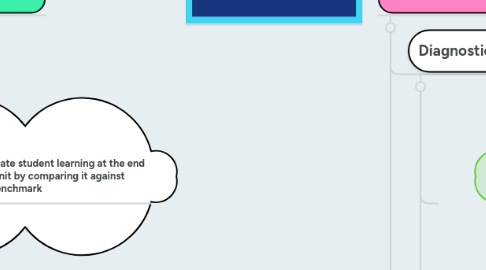
1. Assessments FOR Learning
1.1. Diagnostic
1.1.1. Purpose: To help with diagnosing a students strengths and the areas where improvement is needed.
1.1.2. Advantages
1.1.3. Disadvantages
1.1.4. Example: Having the students take a pre-test (not worth anything) about the intended lessons coming in the days ahead. They would have simple multiple choice questions regarding the various topics in Geography, with a small short answer section asking them to write down any information they know about Geography - including what they think it is.
1.2. Formative
1.2.1. Purpose: To monitor student learning to provide ongoing feedback that can be used by instructors to improve their teaching and by students to improve their learning
1.2.2. Advantages
1.2.3. Disadvantages
1.2.4. Example: I would have students complete a Venn Diagram where one circle may be Washington, DC 50 years ago and the other circle is Washington, DC today. They would have to look at how the community was back then, how it is now, and if there are any parts that have stayed the same (this would be the middle circle, obviously).
1.3. Self-Assessment
1.3.1. Purpose: To involve students deeply in the evaluation of their work so that immediate feedback can be incorporated and used to improve learning
1.3.2. Advantages
1.3.3. Disadvantages
1.3.4. Example: Using the assignment I created in my lesson plan, after the student's wrote their report explaining changes among a certain community, and reasoning behind it, I would come up with a checklist with the class, as a guideline for them to follow. They would then take the checklist, and using a colored pencil, fix, add, or edit anything necessary to make sure they completed the assignment to the fullest. Then I would ask them to give themselves an honest grade of what they believe their report should receive.
1.4. Peer-Assessment
1.4.1. Purpose: To help students to have an understanding of assessment and what constitutes progress and success
1.4.2. Advantages
1.4.3. Disadvantages
1.4.4. Example: I would have the students answers various short-answer questions regarding the different types of maps they learned about. Then, as with the self-assessment, the class would come up with a checklist, or rubric, which they will get a copy of, and use that to guide them when they swap papers with a classmate. They will have to look for definitive answers to some questions; if they are incorrect, or have spelling/grammatical errors, the student assessing the questions would take a colored pencil and correct it according to the rubric/checklist.
2. Assessments OF Learning
2.1. Summative
2.1.1. Purpose: To evaluate student learning at the end of an instructional unit by comparing it against some standard or benchmark
2.1.2. Advantages
2.1.3. Disadvantages
2.1.4. Example: Giving a unit test at the end of each Geography section. This would most likely be after all the Geography topics in the MD state standards have been addressed.
2.2. Authentic
2.2.1. Purpose: To focus on students' analytical skills; ability to integrate what they learn; creativity; ability to work collaboratively; and written and oral expression skills.
2.2.2. Advantages
2.2.3. Disadvantages
2.2.4. Example: Going outside, or having students take pictures of local geographical characteristics, labeling them, and stating whether it is physical or human-made.
2.3. Performance-Based
2.3.1. Purpose: To determine if a student knows how to apply their knowledge, demonstrating what they have learned through a variety of tasks.
2.3.2. Advantages
2.3.3. Disadvantages
2.3.4. Example: For this assessment I would have the students write down reasons for how people effect the environment and how the environment effects the people. They will write down their ideas and thoughts, and then each student will present their reasoning to the class.
2.4. High-Stakes
2.4.1. Purpose: For accountability. It is the attempt by federal, state, or local government agencies and school administrators to ensure that students are enrolled in effective schools and being taught by effective teachers.
2.4.2. Advantages
2.4.3. Disadvantages
2.4.4. Example: This would be if my school was selected to take part in the National Assessment of Educational Progress (NAEP) which covers a vast range of subjects, Geography being one of them.
2.5. Portfolio
2.5.1. Purpose: To document student learning on specific curriculum outcomes.
2.5.2. Advantages
2.5.3. Disadvantages
2.5.4. Example: My students' portfolio's for Geography would be a collection of items that were completed in class, and at home, that relate to the lessons they learned. It could be the rough, and final, draft of a report they wrote about the changes in communities, it could include a project where they had to identify various geographical characteristics, or a peer-reviewed draft of how communities differ from each other, with a copy of the final draft (showing that they revised the draft based off the peer-review).
